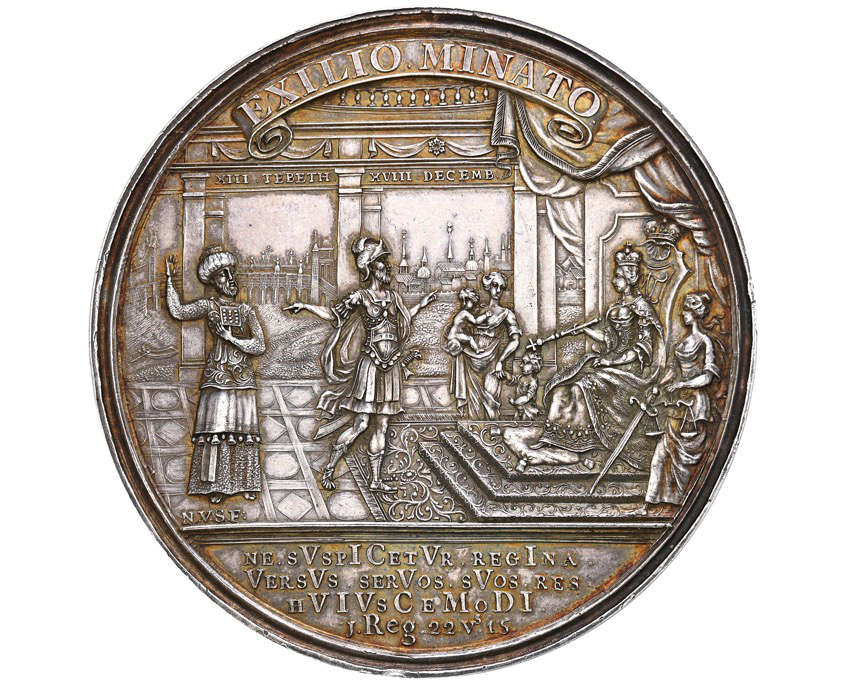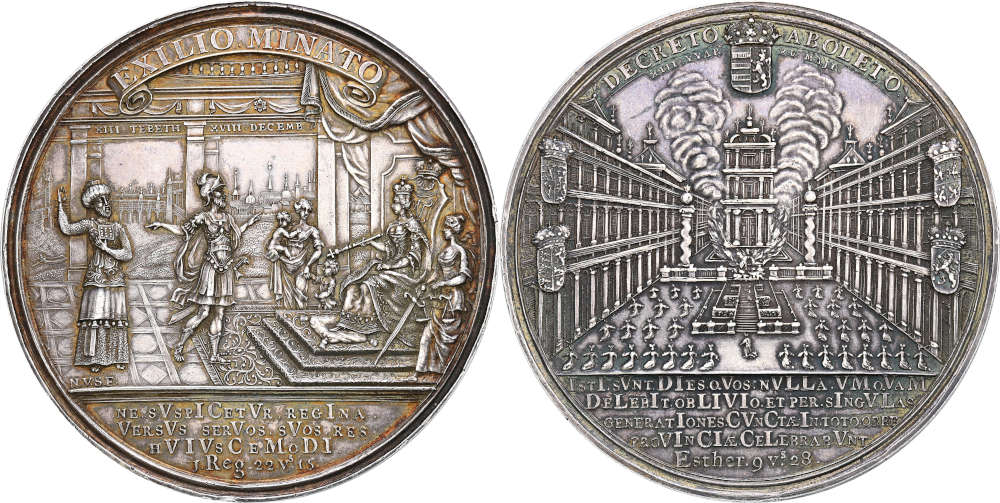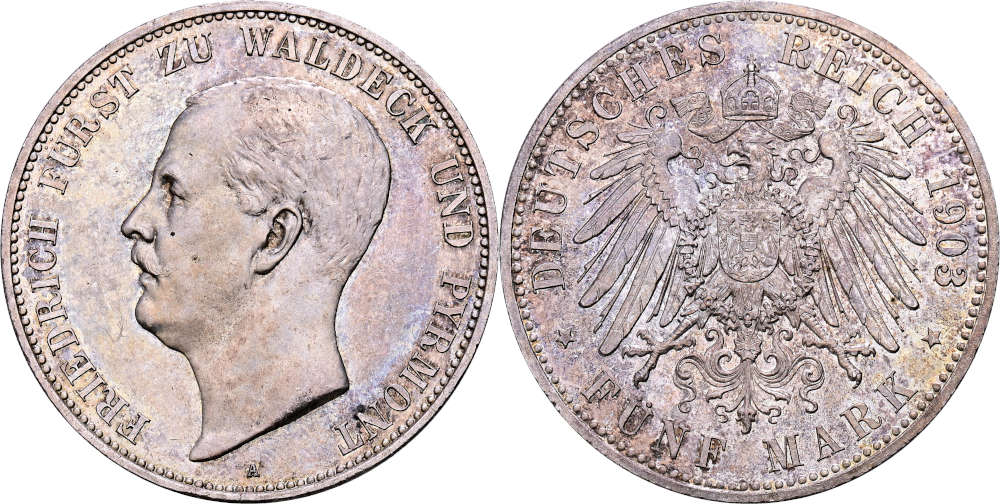A Saxon Wedding, Jewish Everyday Life and Roman Gold
Künker
Auctions 389-390
Coins
23-24 June 2023
D-Osnabrück
Immediately following the two public auction sales 387 and 388, on 23 and 24 June 2023 Künker will hold two eLive Premium Auctions. In addition to world coins and medals from antiquity to present times, numerous special collections are on offer. They include the Dr. Walter Kemlein Collection of coins and medals from Saxony, a special collection with coins from the Duchies of Bremen and Verden, an important collection of Jewish medals from all over the world, part seven of the Salton Collection with Roman coins at favorable estimates and an extensive series of Italian issues as well as coins and medals from the German States.
Catalog 389: World Coins and Medals
Ancient coins, world coins and medals and, of course, the German States: If you are looking for new acquisitions to add to your collection, auction 389 provides you with the perfect opportunity. Estimates range from low two-digit starting prices to some four-figure estimates.
The focus is on issues of the German States. After all, two extensive special collections are presented at once: Bremen and Verden as well as Saxony. However, the small series with Mecklenburg issues should not be neglected either.
An Extensive Special Collection Focusing on Bremen and Verden
Only a few bracteates represent the Catholic past of the Diocese of Bremen, which was merged with the territories of the secularized Bishopric of Verden in the Peace of Westphalia, to come under Swedish rule as an imperial territory. Therefore, coins minted in Stade under Swedish rulers are the main batch in this special collection on Bremen and Verden, which contains about 100 lots. However, it should be mentioned that there are many more coins behind these 100 lots because especially fractional coins were often grouped into carefully arranged multiple lots.
This collection was assembled with great attention to detail and has something to offer for everyone who is interested in this field. Although there are no rarities of top quality, connoisseurs can look forward to coins of above-average quality with fine patinas.
Catalog 389: The Kemlein Collection
It was one of those typical German fates that encouraged Dr. Walter Kemlein to collect the coins and medals of his old Saxon homeland. Born on 24 October 1927, he was one of the last two cohorts that were conscripted into the army shortly before the end of the Second World War. Good luck and helpful fellow men saved him from being held as prisoner in Russia for a long time. Instead, the just 18-year-old could return home and escape to Erlangen three years later, where he started to study medicine. During his many years of service as a trauma surgeon and chief physician at the surgical clinic of the Johannes Hospital in Bielefeld, Dr. Walter Kemlein never forgot his roots. He remembered his old home by assembling an extensive collection of coins and medals that related to Saxony, which will now be entering the market once again. A special focus is on the city of Dresden. More than 250 lots are offered in this auction sale.
Dr. Walter Kemlein acquired a particularly large number of medals, including some pieces that commemorate the Wedding of Frederick Augustus and Maria Josepha in 1719, the so-called “Wedding of the Century”.
Catalog 389: Jewish Medals
Actually, the largest part of the collection of Jewish medals should have also been included in the chapter on the German States because a wealth of issues from the 19th century are from there. They reflect how proud German citizens of the Jewish faith were on their new synagogues, which they were finally allowed to build – in some cases against the resistance of local authorities. Be it Erfurt or Frankfurt, Cologne or Munich, Mainz or Würzburg, numerous synagogues were erected at the time, just to be demolished by the Nazis a few decades later.
However, these medals also recount other stories. They tell of wise rabbis and how the Jewish communities came to develop a new pride in their past in the second half of the 20th century.
Catalog 390: The Salton Collection
The following eLive Premium Auction 390 wonderfully ties in with the collection of Jewish medals, because it contains the seventh part of the Salton Collection, the fate of which we have already recounted on several occasions. Therefore, we will only mention a few key events here. Mark Salton used to be called Max Schlessinger before moving to the United States, and was a descendant of a long line of German coin dealers. His parents, Felix and Hedwig Schlessinger, died in the Holocaust. Max managed to escape. After the end of the Second World War, he moved to New York, where he met his future wife Lottie. The two of them built up a second life there.
This life obviously included the coins they collected. And their collection was typical of the pre-1970s era, as they paid more attention to rarity than to quality. Therefore, the Salton Collection contains both pieces of excellent quality and issues that we would describe as “very fine” today. This enables collectors of Roman coins to consider bidding on an aureus this time, given that estimates start at 2,000 euros. Although, of course, the selection of denarii and bronze coins with estimates starting in the two-digit range is also quite extensive. Be it Roman Republic or Roman Empire, many historically important rarities of very fine quality can be found in this catalog. The material will provide those who are rather interested in history than in coin grades with plenty of opportunities to dream about the past.
But there are also coins for lovers of high-quality pieces. Have a look at the denarii by Hadrian: there are numerous coins with nice portraits whose quality is better than extremely fine. The Saltons were especially interested in this travelling emperor who, despite his love of peace, mercilessly crushed the Bar Kochba uprising. But there are also rarities of attractive quality in the section of the soldier emperors and the tetrarchs.
Please also take a look at all the carefully compiled multiple lots that are definitely worth to be viewed!
Catalog 390: World Coins with a Focus on Italy and the German States
The Salton Collection is a universal collection, which is why many European coins will be on offer as well, including numerous pieces of the finest quality. However, once again, the Saltons paid more attention to rarity than to quality, which is why you will find a comprehensive offer of historically important and rare pieces of very fine quality.
Particularly noteworthy is a series of coins and medals from Italy, which tells of the great love of the Saltons for their third home country. It contains numerous rarities of the finest style, some of which in extremely fine quality.
And there are also many beautiful pieces from the German States.
Submit your bids as the money will go to charitable organizations working for reconciliation and the remembrance of Jewish history!
To order a catalog, contact Künker, Nobbenburger Straße 4a, 49076 Osnabrück; phone: +49 541 / 962020; fax: +49 541 / 9620222; or via e-mail.




























